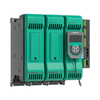Power resistors in vacuum furnaces
Discover the advantages of a robust and performing vacuum oven control system thanks to the power resistors
Power control of the primary of a transformer connected to three-phase graphite heating elements for vacuum furnaces
The GPC power controller provides:
- an accurate control and diagnostics;
- feeds the three-phase load.
Thanks to the control of only two phases in graphite, advantages in terms of costs compared to the three-phase load. Furthermore, the GPC power controller allows to save space in the electrical cabinet and also reduces the heat generated by the SCR (trisistor).
Overview
- Accurate power control of graphite heater connected over 3-phase through a transformer
- Real time process alarms and diagnostic of power control unit
- Advanced power controller to form an integral and robust control system
The process
A vacuum furnace is used for metal / steel / ceramic parts requiring precise heat treatment at high temperature.
Vacuum in the chamber is created by extracting out air end other gases to prevent oxidation, heat loss from the product and remove any source of contamination.
Vacuum furnaces are used for wide range of applications in both production industries and research laboratories. Processes such as annealing, brazing, sintering requiring consistency and low contamination are carried out in the vacuum furnace.
An inert gas such as Argon is often used to quickly cool the treated metals back to non-metallurgical levels (below 200°C) after the desired process in the furnace.
The challenge
The graphite heating elements can operate over 2000°C (3632°F) in an inert or in a vacuum atmosphere only. It is critical process and has to work in auto mode.
Because of non-linear and non-standard operating condition, power controller has to be intelligent and devised to operate factoring below conditions.
Graphite resistance curve
It decreases approximately 20% from 20°C (68°F) to around 500°C (932°F) then increases, until at 3000°C (5432°F) it can be 1.4 times the value measured at 20°C (68°F).
Heater operating voltage 24/70 Vac
Require a transformer 380/480 Vac: 24/70 Vac
Predictive maintenance
Real time diagnostic of the heater and of the power
controller to prevent damages, short circuits and consequent plant shut down.
Product benefits
Functionality of the GPC
- Configurable SCR (Thyristor) firing method
- Configurable control mode to suit different resistance curve of heaters including current limit and power feedback
- Three phases with two or three legs control
- Connectivity: most commonly used Ethernet field bus
- Input signal: manual, 0-10V/4-20mA, via field bus
- Configuration of power controller through PC and/ or hand-held terminal
Various Diagnostic and Predictive maintenance
- Continuous temperature monitoring of power terminals of the controller via 12 embedded thermistors
- Heater break alarm and customised power control strategy for continuous power to heaters
- Monitoring of line voltage, line frequency, load current, load impedance and load power.
Solution
GPC Power controller provides the required control mode of the SCRs and it drives primary of the transformer.
Power feedback control function
To keep the power transferred to the heater constant, compensating for the voltage variation and of the ohmic value variation (up to +30%) caused by oxidation of the heater (Figure 2).
Soft start
Required for the start-up of the furnace when the heater is cold to avoid the damaging of the graphite heaters.
Transformer control: Delay trigger
For the transformer to avoid the “inrush current” that Initially can be 6 – 10 times the rated load current. A dedicated delay trigger feature inserts a trigger delay on the first cycle (as shown in the image below) in order to allow the exhaustion of residual magnetism (Figure 3).
Predictive maintenance
A problem such as loose cable connection can have serious consequences over time. If not properly controlled, the heat increases at the point where the connections could begin to melt or generate sparks that could ignite fire. Predictive maintenance provided with GPC allow to measure the over temperature on all power cables wire clamping in order to prevent dangerous situation.
Self-learning Heater Break alarm setpoint
HB alarm limit depends on the load type / connection and firing mode. Moreover, these thresholds can be different for each controlled phase.
- A Self-learning alarm threshold feature is available for an easy, quick and safe configuration.
- GPC automatically starts a current reading procedure with a list of power output % value and automatically set the suitable threshold.
Optimal configuration
The two-leg control for three phase load (Figure 4) offers cost benefits compared to the 3-leg control. It also saves space in the control cabinet and reduces heat generated by thyristors.





